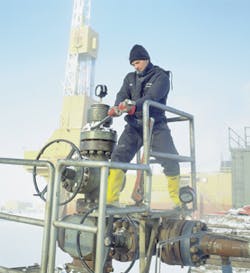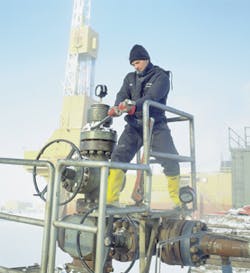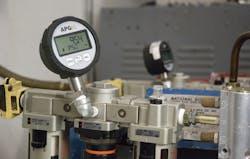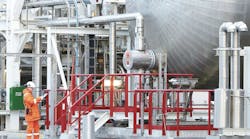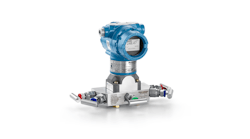Analog (dial) gauge technology has been around for more than 150 years, dating back to the Industrial Revolution when steam processes emerged in machine-age factories and locomotives. Accidents resulting from over-pressure weren’t uncommon, and, as a result, instruments like pressure gauges and safety relief valves came into play to protect workers and everyday citizens from hazardous application scenarios.
Up until about 30 years ago, analog pressure gauges remained relatively unchanged in their basic components, with a Bourdon tube (originally designed by Eugene Bourdon of France) at the heart of the technology. Around this same time, the digital wristwatch came into fashion, and soon afterward a new digital option for pressure gauges was introduced. The digital gauge has been on the rise ever since, but its analog predecessor remains a leading presence in the pressure measurement space. Both have improved over the last 15 years as new materials of construction have become available and new manufacturing techniques and technologies have been introduced, such as laser welding and helium leak testing. This has resulted in mechanical gauges that are more reliable, last longer, provide a more consistent reading, and are less expensive.
Regarding digital gauges specifically, the evolving technology has allowed new, more stable sensing elements to be developed. Higher accuracy measurement can now be made and effects, such as temperature drift, can now be calibrated, allowing the sensor to remain accurate over a wide range of operating temperatures.
Choosing the right gauge
From backyard swimming pools to high-tech laboratories, pressure gauges are found in a wide range of applications. Some of the common uses for pressure gauges are tire pressures, calibration, tank refill, leak detection, process monitoring, and line testing, just to name a few.
Can a case be made for using one gauge versus the other? According to the experts, that question is directly related to what application it will be used for. "It is very important [that] end-users select a pressure gauge that is going to operate the best for them and give them the best results based on what they want to use it for," says Gene Urbinati, global product line director for Mechanical Products at Ashcroft.
Gordon W. Greathouse, applications engineer for Automation Products Group, says the best way to determine whether to use analog or digital gauges is to decide what kind of accuracy is needed for the reading. "How much are you willing to spend?" he asks. "Do you need any type of outputs, and where is this gauge going to be installed?" If an accuracy of 0.5 percent and greater will suffice, and you have a static application and want the least expensive option, an analog gauge would work well. He says digital gauges, on the other hand, will provide a precise, accurate reading – no interpretation is needed – and microprocessor technology will allow for several additional programmable functions.
When considering the modern technology available today, there are some common application issues end-users can more adeptly address with modern-day digital pressure gauges than they could with previous generations of analog devices.
"Accurate, precise readings of low-pressure applications of less than 5 PSI are possible with digital gauges because of microprocessing in digital gauges," says Greathouse. "Leak detection is [also] more precise with digital gauges." He says resolutions of up to .01 or .001 are common with digital gauges, while pressure changes of such small increments are virtually impossible to detect with analog gauges.
Urbinati says digital gauges are more resistant to withstanding over-pressure spikes without sustaining damage (typically 200 percent of the rated pressure range) compared to 130 percent for analog gauges, although analog gauges now have improved features to prevent wear from vibration and pulsation. "Digital gauges may also be more suitable for applications where there is constant pressure pulsation, which could cause an analog gauge to wear out moving parts and the operator to see a constantly moving indicator," says Urbinati. "Digital gauges sample at various rates (typically 100 or 250 milliseconds) to average out small pulsations and display a constant value." Further, he says a digital gauge is desirable when the end-user wants both a local and remote pressure indication, or when an automated process control uses pressure as an input to the control system.
For all the modern advantages of the digital gauge, there are some times when the simplicity of the analog gauge would work best and be more cost-effective. For instance, when only a general reading is required (high, medium, low), an analog gauge would be the best choice. Analog gauges are offered in many different display sizes as well. And one major advantage is that they require no power or batteries.
Common pitfalls & negative impacts
Not being aware of the gauge’s datasheet specifications, unfamiliarity with the gauge’s sensing technology, and over-torquing the gauge during installation, are all common pitfalls end-users face when installing and maintaining pressure gauges. "Too much torque will stress the sensor and cause the calibration to be wrong," says Greathouse. "Gauges should only be installed with just enough torque to prevent any leakage at full scale."
Some common problem causers are pressure pulsation, which can introduce premature wear in analog gauges; vibration; process and ambient temperature, which can affect accuracy, repeatability and functionality; and over-pressure spikes. Other potential problems arise with media that is a slurry or has a high concentration of particulate matter that can clog pressure ports; and corrosion, which can damage both analog and digital gauges. "It’s important to carefully select a gauge with wetted parts that are compatible with the media being sensed," Urbinati says. Many of these potential problems can be avoided by using diaphragm seals and remote mounting, he points out.
According to Greathouse, the biggest cause of poor gauge performance is improper installation and neglect. "Though the designs of gauges currently are very good, a preventative maintenance plan is essential for the longevity of a gauge," he says. "A gauge should be examined and recalibrated at least once a year depending on the intensity of its use. Minor problems can be corrected, and the gauge can be recalibrated and recertified. A gauge that is properly taken care of should last years, if not decades."
Looking forward
Just as people have continued to wear dial wristwatches long after the invention of the digital kind, so will people continue to use analog pressure gauges. Experts say analog devices will remain for those looking for non-powered, free-standing, self-actuated, reasonably priced components. "There is a place for both of these products, and more likely than not, [there] will continue to be," Urbinati says.
In terms of future technology, experts say analog pressure gauges will improve as modern manufacturing techniques are implemented, such as laser welding, automated assembly, and new materials of construction are added. This will result in more reliable, accurate gauges at a lower cost.
On the digital side, there is believed to be much more opportunity for improvements. "New sensor technologies are being developed, which are more cost-effective, consume less power, are accurate, repeatable, and offer a wider range of operating temperatures," Urbinati says.
Steve Andersen, a senior product manager for Aschcroft Inc., contributed to the content of this article.
Amy W. Richardson is the managing editor of Flow Control magazine. Contact her at [email protected].
